

| In 13 BCE, the Roman Senate decreed that the Ara Pacis be built to celebrate Augustus' triumphant return from the wars in Spain and Gaul, although the dedication or official inauguration took place about three and a half years later, in January 9 BCE. This altar to Peace was located in the Campus Martius (the Field of War), a place ironically where the military did exercises. In the succeeding centuries, however, the altar was eventually covered up as the level of the area was raised until finally it was buried and forgotten, only to be uncovered in part in the Renaissance, with slabs of the altar dispersed to various locations. Eventually the area was excavated and slabs were recovered from a number of owners; the altar was restored and installed in its own pavilion in 1938. Today, the Ara Pacis is installed in a new museum, which opened in 2006 (not entirely finished by the time I photographed it). See photographs of this museum by American architect Richard Meier. | ||
The western facade of the Ara Pacis, towards the Campus MartiusThe Ara Pacis is essentially a small building enclosing an actual altar where sacrifices would have been performed. The enclosure is almost square--about 11 and a half meters on the open west and east sides and about 10 and a half meters on the north and south sides. | ||
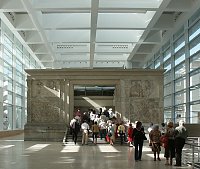
|

|
The exterior is divided into two registers--the lower with acanthus scrolls (or reliefs associated with nature) and the upper with reliefs depicting humans or divinities. The two areas are divided by a band with a meander (or swastika motif)--a design often associated with Trojan and middle eastern cultures. |
The western facade has reliefs depicting events from Rome's legendary history--Aeneas, the mythical founder of Rome performing a sacrifice on the right and the discovery of Romulus and Remus on the left, with the only discernable part of the latter being the head and part of the cuirass of Mars.Relief of Aeneas sacrificing to the PenatesIn this relief a fatherly Aeneas makes an offering at a rustic altar. Behind, the incomplete figure is probably his son Ascanius while before him are two attendants to the ritual, one with a bowl and jug, the other leading a sacrificial sow. The temple in the upper left represents the Penates, the household gods of the Trojans, saved from the fires of Troy. However, Stokstad asserts that the figure, usually identified as Aeneas, might more convincingly be identified as Numa Pompilius, the second king of Rome associated with peace, in contrast to the first king of Rome, Romulus, depicted on the left side panel, associated with belligerence. | ||
| Augustus, as Pontifex Maximus, would have had access to the Temple of Vesta where the Penates were kept. Thus a symbolic association is made between Augustus and Aeneas, the legendary founder of Rome. | 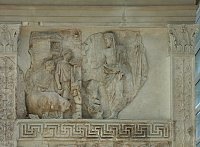
|

|
Relief from the eastern facade: the panel of TellusThe central figure is usually identified as Tellus, or Mother Earth, although earlier she was defined as a personification of Italy and recently as Venus genitrix (Aeneas' divine mother) or as a personification for Peace, bestowing prosperity, or as Ceres, goddess of harvests. The two children on her lap have been interpreted as the nephews and heirs to Augustus, Gaius and Lucius Caesar. | ||

|
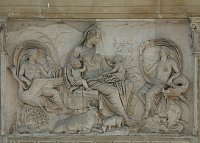
|
|
| According to Rossini, the figure to the right of the central goddess is a representation of the beneficial earth. An "aura velificans" from the Hellenistic tradition, she holds the hem of her billowing gown and rides on the back of a swan. Stokstad identifies the figure as a personification for the land wind with the jug of fresh water and the vegetation at her feet representing the fertility of Roman farms. | 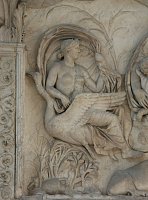
|

|
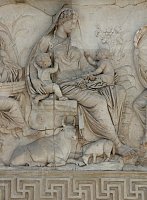
|

|
The central goddessWearing a chiton that emphasizes her breasts and abdomen, the figure also is veiled with a headband of flowers and fruit. Her lap contains fruit as well, all to emphasize the fecundity associated with the goddess. A sheep and cow rest at her feet. Poppies, ears of wheat and lilies (?) appear in the background. The two chubby children which she nourishes represent the Roman people symbolically. |
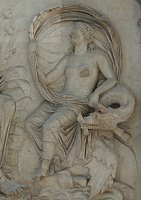
|
According to Rossini, the figure to the left of the central goddess is a representation of the sea winds. An "aura velificans" from the Hellenistic tradition, she holds the hem of her billowing gown and rides on the back of a sea serpent. | |
Vegetal friezesThese friezes, representing more than fifty identified species, may operate symbolically as well, suggesting rebirth and fruitfulness associated with Augustus' reign. The friezes run along the lower sides of the enclosure. Scholars believe it would have been enhanced with color. Scrolls unfold from the acanthus at the bottom. (Acanthus was often a symbol for regeneration.) | ||
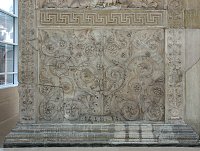
|

|
The stem originating at the bottom center divides the relief pattern into two halves. Ivy, grapes leaves and even small insects and animals (like lizards, scorpions, and snails) inhabit the reliefs and more than twenty swans are spaced along the frieze. See page 3. |
Works Consulted:
Orietta Rossini. Ara Pacis. Rome: Electa, 2006.
Marilyn Stokstad. Art History. Upper Saddle River, N.J.: Pearson Edu., 2005.
 Click here to return to index of art historical sites.
Click here to return to index of art historical sites.
 Click here to return to index of artists and architects.
Click here to return to index of artists and architects.
 Click here to return to chronological index.
Click here to return to chronological index.
 Click here to see the home page of Bluffton University.
Click here to see the home page of Bluffton University.

